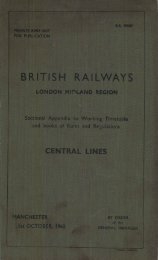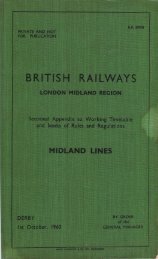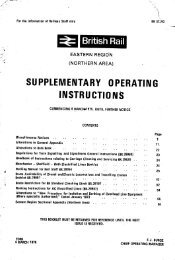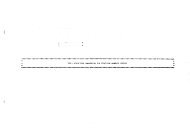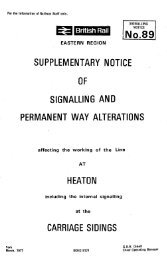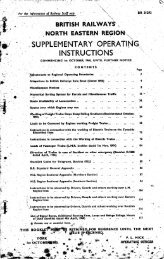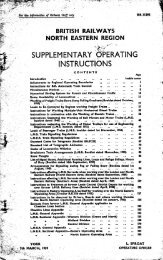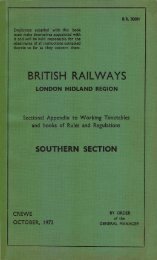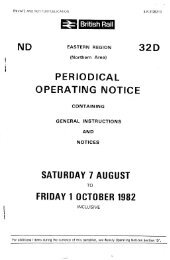general instructions. - Limit Of Shunt
general instructions. - Limit Of Shunt
general instructions. - Limit Of Shunt
Create successful ePaper yourself
Turn your PDF publications into a flip-book with our unique Google optimized e-Paper software.
20 Extracts from Block Telegraph Regulations for the guidance of Engine<br />
Drivers and others not supplied with a copy of the<br />
Block Telegraph Regulations.—Continued.<br />
Single Lines worked by Electric Train Staff and Electric Train Tablet. —<br />
Continued.<br />
Regulation 14A.<br />
traffic — is likely to be stopped for a considerable time, special arrangements<br />
must be made for working the trains to and from the staff or tablet station<br />
on (a) each side of the point of obstruction. The staff or tablet must be retained<br />
to Swork h otrains u lbetween d the point of obstruction and the staff or tablet station<br />
from a which n the staff or tablet was issued, and on the other side, the traffic<br />
must be conducted by a pilotman, in accordance with the following<br />
<strong>instructions</strong> a c c ;--- i<br />
d e n t<br />
o<br />
(b) If the obstruction is caused by a derailed or disabled train, the<br />
guard r must put the engine-driver in charge of the point of obstruction,<br />
and, o after b giving s t him a written order instructing him not to move his<br />
engine r uuntil che treturns<br />
with the pilotinan, must go himself to the end of the<br />
section to which the train was proceeding, and arrange for three or more,<br />
as imay obe n necessary, of the printed forms provided for the purpose of establishing<br />
o working c by pilotman during obstruction, to be filled up ; one of these<br />
must c be delivered u to the signalman in charge of the staff or tablet station<br />
where pilot working commences, the second must be retained by the pilotman<br />
and r the third , must be conveyed by the pilotman with the relief train to the<br />
engine-driver a<br />
in charge of the point of obstruction. The pilotman must<br />
wear n the distinctive badge provided for that purpose, which, until the regular<br />
badge can be obtained, must be a red flag tied round the left arm. So soon<br />
d<br />
as he is satisfied that the arrangements are understood, trains may be allowed<br />
to tgo<br />
on to the single line under the control and by the permission of the<br />
pilotruan. h The engine-driver, when put in charge at the point of obstruction,<br />
e must hand the staff or tablet to the fireman, and instruct him to take<br />
it back to the staff or tablet station from which it was issued, to work trains<br />
between that station and the point of obstruction until the line is clear.<br />
(c) The regulation badge is a red armlet, with the word " Pilotman " shown<br />
thereon in white letters.<br />
(d) The line on each side of the obstruction must be protected in accordance<br />
with Rule 217 in the Book of Rules and Regulations, and the guard and<br />
fireman will be held responsible for taking care that this is done until the<br />
men are appointed specially to perform the duty.<br />
(e) When the line is again clear, no train must be allowed to pass the point<br />
where the obstruction existed without the staff or tablet ; the pilotman<br />
must accompany the first train carrying the staff or tablet to the staff or<br />
tablet station to which the train was proceeding at the time of the accident.<br />
After the engine-drivpr has given up the staff Qr tablet to the signalman,<br />
and the pilotman has withdrawn his arrangements for pilot-working, the traffic<br />
must again be conducted in accordance with these regulations.<br />
(I) In no case of obstruction away from a staff or tablet station must a<br />
staff or tablet be restored to the instrument at either end of the section until<br />
the section is clear, except as laid down in Regulation 19.




